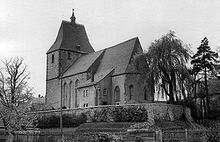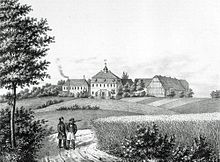Eula (Borna)
|
Eula
Large district town of Borna
Coordinates: 51 ° 9 ′ 3 ″ N , 12 ° 30 ′ 56 ″ E
|
||
|---|---|---|
| Height : | 145 m above sea level NN | |
| Residents : | 997 (2004) | |
| Incorporation : | March 1, 1994 | |
| Postal code : | 04552 | |
| Area code : | 03433 | |
|
Location of Eula in Saxony |
||
Eula is a district and a village in the Saxon city of Borna in the Leipzig district . The districts of Eula, Kesselshain, Haubitz and Gestewitz belonged to the Borna village of Eula.
Geography and traffic
Eula is located about 23 kilometers south-southeast of the Saxon city of Leipzig on the Eula stream of the same name, which flows from east to west . To the west of the village, the federal highway 95 runs in a north-south direction , it merges into the federal highway 72 south of Kesselshain . Shortly before the start of the autobahn, federal highway 176 branches off to the east.
Neighboring towns of Eula are Thierbach in the northeast, Braußwig and Dittmannsdorf in the east and the districts of Kesselshain in the south, Haubitz in the west and Gestewitz in the northeast, which belonged to the municipality of Eula before 1994.
Eula and its districts are located in the renatured area of the Witznitz I and II and Borna-Ost / Bockwitz opencast mines . Therefore, there are several lakes around the places with the Haubitzer and Bockwitzer lakes and the Witznitz reservoir .
history
Eula
The village of Eula was first mentioned in 1090 as a settlement with the name "Hyla". The village of Eula probably got its name from the Slavic word “ilu”, clay, because the Eula brook flows through a clay area. The first documented form of place names dates from 1378 as Ila or Yla .
The oldest building in the village is the Wiprechtskirche , which is visible far over the floodplain of the Eula . The legend ascribes the foundation of the church to Wiprecht von Groitzsch . He was related by marriage to the house of the Wettins and drove the German settlement between Elster and Mulde . On one of his trips between Leisnig and Groitzsch , he is said to have found a poor wooden church in the village of Yla and then had the stone church built at his expense in 1106. The church received its late Gothic form in the 15th century.
The village of Eula is still characterized by a rural character, has an industrial park, private home locations, numerous trading, service and handicraft businesses as well as agricultural companies. A popular meeting place for young and old is the newly built club house in Eula, where a lively sporting and cultural club life is maintained.
In 1815 August Schumann mentions Eula in the state, post and newspaper encyclopedia of Saxony concerning a. a .:
"It belongs amts. zum Rittergute Kesselshain, has 45 houses, 220 residents, a parish church and a school. Among the inhabitants there are 4 Anspänner , 10 Hintersäßer , 4 gardeners and 15 cottagers ; 1 mill with 3 courses also belongs to the village. The ground is sandy and the area is very pleasant. The inhabitants live from agriculture and animal husbandry; they keep their own sheep reefs in their corridors for a herd of 300 grafted cattle. Here is a mother church to which the Thierbach branch belongs, and where the villages Kesselhain, Brauswig, Gestwitz, Haubitz and Klein-Zössen are parish. The Collatur , the landowner of boiler grove; Church and school are subject to the Borna Inspection. - The church stands on a hill, its square tower can be seen from afar; it is an old building. The parish has a strong field management, a parish wood and a small parish-Dotal jurisdiction. "
Kesselhain
Kesselshain, so named as early as 1350, is a small village that has been part of Eula for a long time, only separated by the Eulabach. The place name means something like "the settlement that is on the grove in the basin", ie in a depression. The manor itself is partly surrounded by orchards and vegetable gardens, partly by ponds and grass gardens and, with the few houses in the village, is located in the friendly meadow floodplain that is irrigated by the Eula. In front of the manor there is a free space planted with tall linden trees, at the entrance of which there is a centuries-old, strong oak of rare size with huge branches. It is called "Luther Oak" because the legend goes that Luther preached under it on his return from the Wartburg via Borna to Grimma . The first houses in the Kesselshain settlement south of Eula were built in 1936/37.
Gestewitz
Gestewitz is one kilometer north of Eula on the B 95 . It was first mentioned in 1378 as Gostewicz and means something like "people of the guest". In Gestewitz there was a manor, a little out of the way.
Howitzer
The small round village between the Witznitzer reservoir in the south and the Hainer See in the north was first named as Hugewicz in 1350. The place name results from the German- Old Sorbian mixed name Hugovici "Place of the people of Hugo". It is considered the headquarters of the von Haugwitz family . The place is still dominated by agriculture and shines with its beautiful half-timbered houses. Between 1911 and 1949, the Witznitz I opencast mine was active south of the town, and the Witznitz reservoir is now located in the remaining hole. Between 1975 and 1990, construction site III of the Witznitz II opencast mine devoured the area north of the village. The Haubitz, west of Eula, is already a popular starting point for the Hainer See with the Haubitzer Bay and its surrounding landscape, which was created after the renaturation of the disused Witznitz II opencast mine.
Common history of the districts
Eula with the manor Kesselshain, Gestewitz and Haubitz were in the Electoral Saxon and Royal Saxon Office of Borna until 1856 . From 1856 the places belonged to the Borna court office and from 1875 to the Borna district administration .
Eula has always been characterized by agriculture. At the beginning of the 20th century, lignite mining took hold, which also increased the population. In 1935 Gestewitz and in 1948 Haubitz were incorporated into Eula.
On March 1, 1994 Eula was incorporated into Borna with its former districts Kesselshain, Gestewitz and Haubitz. Since then, Eula has been a village with its own local council.
On January 30, 2015, the church's sacristy was destroyed by fire. A spread to the main part of the church could be prevented, but damage was caused by soot.
Development of the population
|
|
|
People from Eula
- Johann Christoph Bauriegel (1773–1850), educator and operator of a private teacher training college in Peres-Pulgar
- Günther Kleiber (1931–2013), SED politician
literature
- Eylau, Eula . In: August Schumann : Complete State, Post and Newspaper Lexicon of Saxony. 2nd volume. Schumann, Zwickau 1815, p. 589 f.
- Eyla . In: August Schumann : Complete State, Post and Newspaper Lexicon of Saxony. 15th volume. Schumann, Zwickau 1828, p. 728 f.
- Richard Steche : Eula. In: Descriptive representation of the older architectural and art monuments of the Kingdom of Saxony. 15. Issue: Amtshauptmannschaft Borna . CC Meinhold, Dresden 1891, p. 24.
- Matthias Donath : Palaces in Leipzig and the surrounding area . edition Sächsische Zeitung Redaktions- und Verlagsgesellschaft Elbland mbH, Meißen 2013, p. 10, Gestewitz p. 132.
- Eckhart Leisering: Acta sunt hec Dresdene - the first mention of Dresden in the document dated March 31, 1206 , Saxon State Archives, Mitteldeutscher Verlag (mdv), Halle / Saale and Dresden 2005, pages 96, ISBN 978-3-89812-320-4 . Explanations and first mention of Eula and Konrad von Eula pp. 13/54
- GA Poenicke (Ed.): Album of the manors and castles in the Kingdom of Saxony based on nature, newly recorded by F. Heise, Architect. I. Section: Leipziger Kreis. Leipzig 1860, Rittergut Gestewitz, pp. 199–200 (digitized)
- GA Poenicke (Ed.): Album of the manors and castles in the Kingdom of Saxony based on nature, newly recorded by F. Heise, Architect. I. Section: Leipziger Kreis. Leipzig 1860, Kesselshain, Appendix p. 8 (digitized)
Web links
- Eula in the Digital Historical Directory of Saxony
- Gestewitz in the Digital Historical Directory of Saxony
- Haubitz in the Digital Historical Directory of Saxony
- Kesselshain in the Digital Historical Directory of Saxony
Individual evidence
- ↑ Eula district on borna.de , accessed on January 2, 2012.
- ↑ The districts of the city of Borna
- ↑ a b Cf. Eula in the Digital Historical Directory of Saxony
- ↑ The church with its mighty defense tower, which is one of the oldest churches in Saxony, has an Urban Kreutzbach organ. Wiprechtskirche Eula , accessed on January 2, 2012.
- ↑ Eula (Borna) . In: August Schumann : Complete State, Post and Newspaper Lexicon of Saxony. 2nd volume. Schumann, Zwickau 1815, p. 589 f.
- ↑ Description of the Witznitz I and II opencast mines
- ^ Karlheinz Blaschke , Uwe Ulrich Jäschke : Kursächsischer Ämteratlas. Leipzig 2009, ISBN 978-3-937386-14-0 ; P. 62 f.
- ↑ The Amtshauptmannschaft Leipzig in the municipal register 1900
- ↑ See an excerpt from the chronicle of the district Eula on borna.de , accessed on January 2, 2012.
- ^ Area changes from January 1, 1994 to December 31, 1994 on the website of the State Statistical Office of the Free State of Saxony. P. 20. (PDF; 64 kB), accessed on January 2, 2012.
- ^ The local council Eula on the website of the city of Borna
- ↑ Fire near Leipzig: Church fire causes high damage. , accessed February 6, 2015






